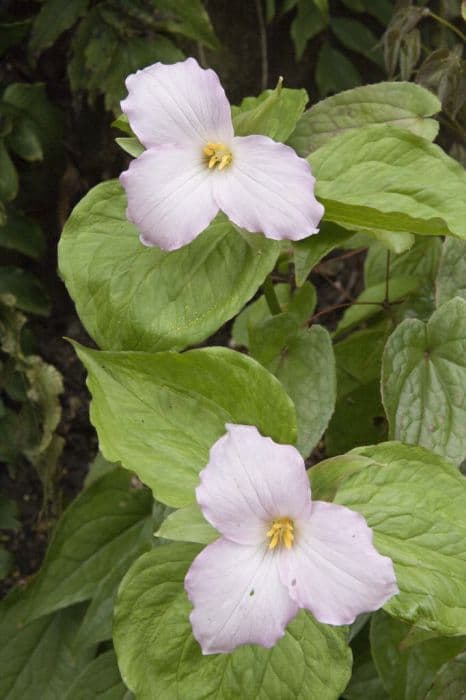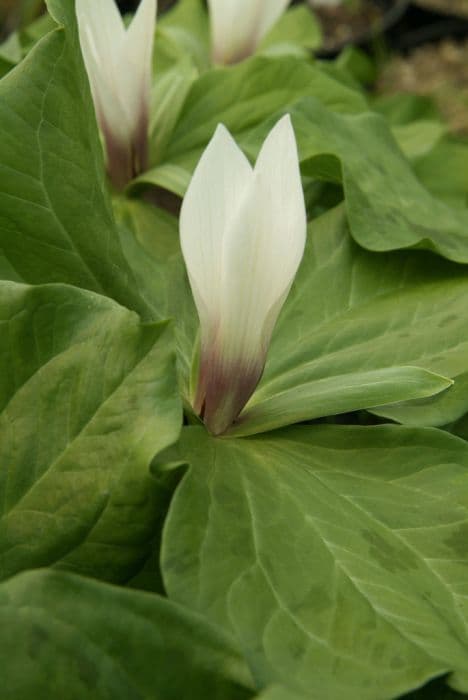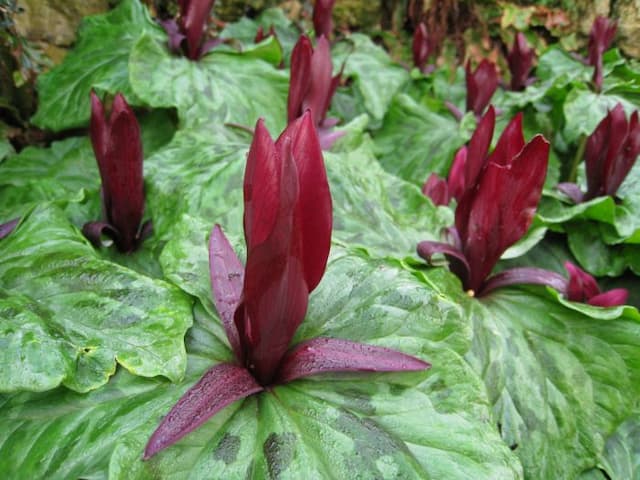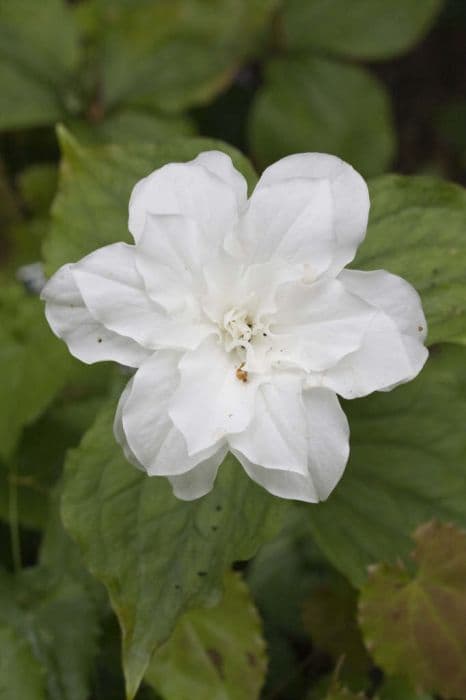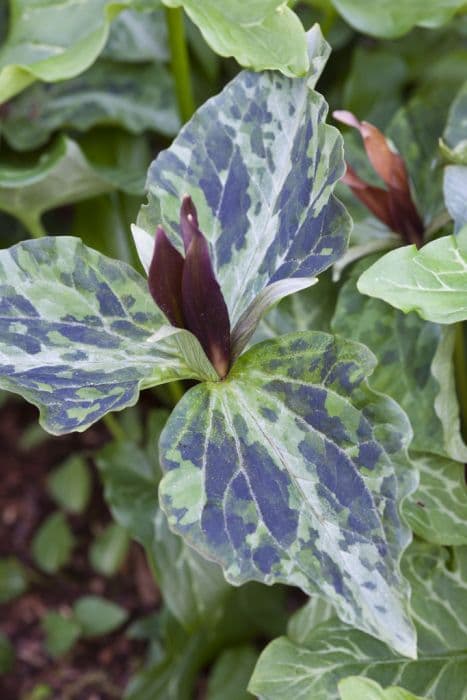White Hellebore Veratrum album

ABOUT
The plant commonly known as White Hellebore has a robust and upright stature, comprised of a cluster of large, broad leaves at the base and a flowering stem that bears numerous flowers. The leaves are spirally arranged, pleated, and can be quite substantial in size, contributing to the plant’s bushy appearance. The greenery is a deep, lush green peppered with parallel veins, offering a sense of texture and strength. As for the flowers, they are star-shaped with a creamy white coloration, sometimes tinged with green, clustered together in a dense, branched arrangement at the top of the stem. Each flower possesses three large sepals which resemble petals due to their size and color, with smaller, true petals nestled between them. The center of the flower is populated by a conspicuous array of stamens, typically yellow in color, surrounding the central pistils. The overall impression of White Hellebore is one of a substantial and impressive plant, marked by its large, pleated foliage and striking, complex flowers that boast a multitude of layering parts — a captivating sight that belies its toxic nature.
About this plant
 Names
NamesFamily
Melanthiaceae.
Synonyms
White Hellebore, European White Hellebore, False Hellebore, White Veratrum.
Common names
Veratrum lobelianum, Veratrum schackianum.
 Characteristics
CharacteristicsLife cycle
Perennials
Foliage type
Deciduous
Color of leaves
Green
Flower color
White
Height
3-6 feet (0.9-1.8 meters)
Spread
1-3 feet (0.3-0.9 meters)
Plant type
Herb
Hardiness zones
3-7
Native area
Europe
Benefits
 General Benefits
General Benefits- Ornamental Value: Veratrum album, commonly known as white hellebore, has striking foliage and prominent flower spikes that enhance the aesthetic appeal of gardens and natural landscapes.
- Insect Repellent: The plant is known to naturally repel certain insects, which can be beneficial for protecting other plants in the garden.
- Wildlife Habitat: White hellebore can provide shelter and habitat for various insect species, contributing to biodiversity in the area where it grows.
- Soil Stabilization: The root system of Veratrum album can help prevent soil erosion in hilly or mountainous areas.
- Cultural and Historical Significance: The plant has a rich history of use in folklore and mythology, offering cultural value and interest.
 Medical Properties
Medical Properties- Alkaloid Content: Veratrum album, commonly known as white hellebore, contains steroidal alkaloids such as veratridine, which affect the cardiovascular system.
- Historical Use for Hypertension: Traditionally, it was used in small doses to treat high blood pressure, although it is not considered safe due to its toxicity.
- Anti-Inflammatory Effects: Research on animals suggests that extracts might have anti-inflammatory properties, but their use in humans for this purpose is not established.
- Potential Anticancer Activity: There is some preliminary research indicating that compounds in Veratrum album may have anticancer properties, but this is not yet used in conventional medicine.
- Pain Management: In history, some cultures have used Veratrum album for its potential pain-relieving properties; however, its use is not safe and can lead to poisoning.
 Air-purifying Qualities
Air-purifying QualitiesThis plant is not specifically known for air purifying qualities.
 Other Uses
Other Uses- Insecticide: Veratrum album, commonly known as white hellebore, has been traditionally used as an insecticide. Its alkaloid content can deter or kill pests when applied to plants.
- Folk Magic: In some cultures, white hellebore is believed to have protective properties and is used in rituals to ward off evil spirits.
- Photography: The juice of white hellebore was historically used as a component of certain photographic solutions during the early development of the photography process.
- Animal repellent: The strong odor and toxic properties of white hellebore make it useful for repelling moles, voles, and other rodents from gardens.
- Taxidermy: White hellebore powder has been applied in the taxidermy process as a preservative to prevent decay and insect damage to specimens.
- Fishing: Some fishing practices included the use of white hellebore as a piscicide to catch fish by temporarily stunning them, making them easier to collect.
- Adhesives: The plant has been historically used to produce a sort of natural glue or binding agent for various applications.
- Dyeing: The roots of the white hellebore may yield a yellow dye that has been used in textile dyeing processes.
- Horticultural beauty: While not advisable due to its toxicity, white hellebore is sometimes cultivated purely for its aesthetic value in gardens with controlled access to prevent accidental poisonings.
- Livestock marking: A paste made from white hellebore has been used to mark sheep and cattle due to its visibility and persistence.
Interesting Facts
 Feng Shui
Feng ShuiThe White Hellebore is not used in Feng Shui practice.
 Zodiac Sign Compitability
Zodiac Sign CompitabilityThe White Hellebore is not used in astrology practice.
 Plant Symbolism
Plant Symbolism- Danger: Veratrum album, commonly known as white hellebore, is highly toxic. Its symbolism often relates to danger and the importance of caution in uncertain situations.
- Deception: Despite its attractive appearance, white hellebore is deceptive due to its poisonous nature, symbolizing that things may not always be as they appear.
- Purity: The color white typically symbolizes purity and innocence, which may be contrasted with the plant's toxic properties, offering a dichotomy between appearance and reality.
- Protection: Historically, white hellebore was believed to ward off evil spirits and can symbolize protection against negative influences.
 Water
WaterWhite Hellebore should be watered deeply but infrequently, allowing the soil to dry out slightly between waterings. Typically, this would translate to once a week during active growth, with about 1 to 1.5 gallons depending on the size of the plant and the environmental conditions. It's important to avoid waterlogged conditions as this can lead to root rot. During dormancy, in the cooler months, reduce watering to every other week or less, monitoring the soil moisture level.
 Light
LightWhite Hellebore thrives best in areas where it can receive partial to full shade. The ideal spot for this plant is under the canopy of deciduous trees where it gets dappled sunlight or in an area that receives morning sun and afternoon shade. It is not suited for prolonged exposure to direct, intense sunlight, especially in hot climates.
 Temperature
TemperatureWhite Hellebore prefers cool to moderate temperatures and can survive in temperatures ranging from about 20°F to 70°F. The ideal temperature range for growing White Hellebore is between 50°F and 60°F. It is hardy and can tolerate cold winters but should be sheltered from extreme heat.
 Pruning
PruningWhite Hellebore should be pruned to remove dead or damaged foliage and to maintain its shape. Pruning is typically done in late winter or early spring before new growth begins. Cut back the old leaves to the ground to make room for fresh growth. It's not necessary to prune extensively unless the plant has become overgrown.
 Cleaning
CleaningAs needed
 Soil
SoilThe best soil mix for the White Hellebore should be rich, well-draining, and consistently moist. A mix of loam, sand, and peat with a pH ranging from 5.5 to 7 is ideal for this plant. Providing organic matter such as compost will also help to fulfill its nutritional requirements.
 Repotting
RepottingWhite Hellebore typically does not require frequent repotting. It should be repotted once every 2 to 3 years or when the plant outgrows its current pot. It prefers to be left undisturbed, so minimal repotting is recommended.
 Humidity & Misting
Humidity & MistingWhite Hellebore thrives in moderate to high humidity conditions. Although it is adaptable, maintaining a humidity level of around 40-60% is optimal for this plant's health and growth.
 Suitable locations
Suitable locationsIndoor
Provide bright, indirect light and cool temperatures.
Outdoor
Part shade, moist soil, shelter from wind.
Hardiness zone
3-7 USDA
 Life cycle
Life cycleWhite hellebore (Veratrum album) begins its life cycle as a seed, which upon germination, emerges as a small rosette of leaves. The plant grows vegetatively for a few years, developing a strong root system. Once mature, it produces a tall flowering stalk during the summer, which bears numerous small, star-shaped flowers. After pollination, these flowers develop into capsules containing the seeds. The seeds are then dispersed, often by wind or animals, to begin a new cycle. White hellebore is a perennial plant, so after flowering, it will die back to its rootstock to survive the winter and regrow the following spring.
 Propogation
PropogationPropogation time
Spring-Early Summer
The most popular method of propagation for Veratrum album, commonly known as White Hellebore, is through seed sowing. The best time to sow seeds is in fall as this aligns with the plant's natural cycle of seed dispersion and ensures a period of cold stratification, which is necessary to break seed dormancy. To propagate by seeds, they should be sown in a cold frame as soon as they are ripe. The cold frame simulates natural winter conditions, exposing seeds to cold temperatures while providing protection from extreme weather. It can take up to one or two years for germination to occur, and once seedlings are large enough to handle, they can be transplanted into individual pots and grown in cooler conditions until they are established enough to plant out in their permanent positions in late spring or early summer. It's important to handle this plant with care during all stages of propagation, as all parts of White Hellebore are poisonous if ingested.
